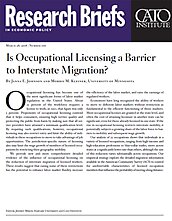Occupational licensing has become one of the most significant forms of labor market regulation in the United States. About 25 percent of the workforce requires a license to work; in 1950, that figure was only 5 percent. Proponents of occupational licensing contend that it helps consumers, ensuring high service quality and protecting the public from harm by making sure that all service providers have attained a minimum qualification level. By requiring such qualifications, however, occupational licensing may also restrict entry and limit the ability of individuals in these occupations to move to take advantage of job opportunities. The jurisdiction-specific nature of licensing also may limit the wage growth of members of licensed occupations by restricting their geographic mobility.
We provide new and more comprehensive detailed evidence of the influence of occupational licensing on the reduction of interstate migration of licensed workers. These results suggest that easing some of these restrictions has the potential to enhance labor market fluidity, increase the efficiency of the labor market, and raise the earnings of regulated workers.
Economists have long recognized the ability of workers to move to different labor markets without restriction as fundamental to the efficient functioning of those markets. Most occupational licenses are granted at the state level, and often the cost of attaining licensure in another state can be significant, even for those already licensed in one state. If the rise in occupational licensing restricts interstate mobility, it potentially subjects a growing share of the labor force to barriers to mobility and subsequent wage growth. Our analysis of 22 occupations shows that individuals in a variety of licensed occupations, ranging from high-income and high-education professions to blue-collar trades, move across states at a significantly lower rate than others, although the size of this reduction varies substantially across occupations.
Our empirical strategy exploits the detailed migration information available in the American Community Survey (ACS) to control for unobservable characteristics of licensed occupation members that influence the probability of moving a long distance.
We show that occupations with state-specific licensing requirements, such as exams, experience the largest reductions in interstate migration, whereas the interstate mobility of occupations that require passage of a national exam for licensure is generally no lower than that of nonlicensed occupations. We find evidence of a causal link between state licensing requirements and the interstate migration of lawyers. We also provide approximations of how the limiting effects of occupational licensing reduce the total annual earnings of licensed individuals because those workers do not experience additional earnings growth from changing jobs.
The limiting effect of occupational licensing on interstate migration can provide insights into two yet-unexplained trends: the decreases in interstate migration and in labor market churn over the past three decades. Annual interstate migration fell from 3 to 1.5 percent between 1980 and 2010, and annual job-to-job flows fell from 16 to 11 percent over the same time period. If occupational licensing decreases interstate migration by 20 percent, as our results suggest, the increase in licensing can account for about 4 percent of the decline in interstate migration and 1.2 percent of the decrease in job-to-job flows between 1980 and 2015. To put our estimates in perspective, the aging of the U.S. population accounts for 10 percent of the decline in interstate migration between 1980 and 2015 and 9 percent of the decline in job-to-job flows between 1998 and 2010.
NOTE:
This research brief is based on Janna E. Johnson and Morris M. Kleiner, “Is Occupational Licensing a Barrier to Interstate Migration?,” NBER Working Paper no. 24107, December 2017, http://www.nber.org/papers/w24107.
